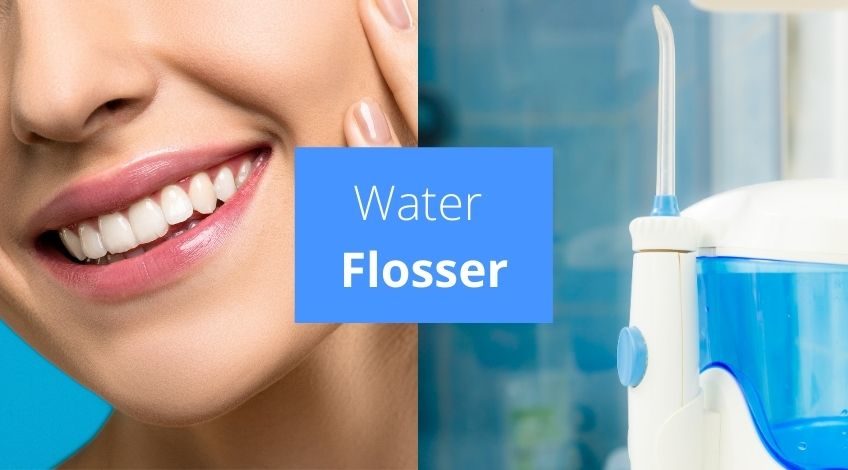
How To Use A Water Flosser
According to the NHS website, we should all be using interdental brushes as well as brushing our teeth. They also advise that if you don’t have enough spaces between your teeth to use an interdental brush, you should floss instead. Flossing removes plaque from between your teeth and can prevent tooth decay and gum disease.
The problem with using dental floss is, it can be quite harsh and lead to bleeding and inflamed gums. A gentler alternative is using a water flosser. Oral irrigation is a quick easy and pain-free way to achieve oral hygiene.
Why Floss Your Teeth?

We all know it’s important to brush our teeth every day, but the toothbrush only cleans the top and outer edges of our teeth. To reach the tartar, plaque and food build-up between the teeth we need to floss regularly. Otherwise, we run the risk of gum disease which causes pain, sensitivity and tooth loss.
Antimicrobial mouthwash helps, but to remove food and plaque properly requires flossing. A water flosser is a softer, less harsh way to clear these hard to get pieces of food and plaque from between our teeth. Particularly useful for children and those of us with low manual dexterity, water flossing is a painless, quick and easy way to clean your mouth.
Who Will Benefit From Using A Water Flosser?
As we just mentioned using a water flosser is ideal for children and adults especially the less dextrous amongst us. But they’re not the only people that can benefit from using a water flosser. People who wear braces often find using a water flosser makes cleaning around the wires a much easier solution.
In fact, everyone will find using a water flosser a gentle way to clean teeth effectively. People who have crowns often find dental floss gets stuck under the crown. Leaving them worried they might dislodge the crown and need a trip to the dentist to have it replaced. Using a water flosser will solve that particular problem and many others too.
How To Use A Water Flosser
According to dentists, if possible you should use both regular floss and a water flosser to ensure dental hygiene. At first, using a water flosser can be a messy business but practice makes perfect. And soon you’ll be flossing with no mess at all.
Follow our step by step guide to clean your teeth and gums thoroughly and get the best from your water flosser.
- Fill The Reservoir with water
Remove the top of the water container and fill with tepid (lukewarm) water. Empty after every use, there’s nothing worse than rinsing stale water through your mouth. Some people add some mouthwash to the water tank. - Choose the correct tip
Most water flossers come with a selection of tips, usually including a pick tip, a jet tip, an orthodontic tip, a plaque tip and a toothbrush tip. - Connect the tip to the handle
Either by pushing a button on the handle or by twisting the tip into the handle. If you’re not sure consult your handbook for further instructions. - Point the tip into the sink
Turn on the flosser and increase to full power once you see a steady flow of water, turn the flosser off. This is to ensure the water pump is primed. - Lean over the sink
Place the tip in your mouth, start with the back teeth. Keep the tip just away from your teeth and gums. - Turn the water flosser on
Start at a low-pressure setting and increase to a comfortable level. - Be sure to floss each tooth
Starting at the back of the mouth, work all around each tooth, between the teeth, along the gum line. Concentrate the water jet on each area for around 2 seconds. Do this front and back, and both sides of the mouth. The whole process takes around 2 to 2 ½ minutes from start to finish. - Empty the reservoir
Once you’ve finished, pour any remaining water in the reservoir down the sink. Stale standing water can encourage bacterial growth, it’s always best practise to discard water and refill before every use.
What Are The Different Tips For?
Most water flossers come with 5 different tips, these tips have different uses and it’s always best to use the best tip for the purpose it’s been designed for. Let’s have a quick look at each tip, and what it’s for.
- The jet tip
This is used to apply water directly to teeth and gums. - The plaque tip
This is used to reach around bridges, implants and crowns. - The toothbrush tip
This is used to improve the brushing of your teeth by sending a steady flow of water as you brush. - The pik tip
This is designed to remove plaque from deep periodontal pockets and is suited to people who have periodontitis. - The orthodontic tip
This is designed for use with braces. It can remove debris and plaque from hard to reach places like underwires, and around brackets.
Frequently Asked Questions
You can brush your teeth before or after using a Waterpik or other water flosser. It is better to brush your teeth after using the water flosser as it will give a cleaner surface for the brush to reach as all the debris and plaque has been removed.
You should use your water flosser every day.
Water flossing can not damage your teeth or gums, in fact, it has been clinically proven not to cause any damage.
You can use tap water in your water flosser or you can use mouthwash.
You can share a water flosser because it uses interchangeable tips, each family member can have their own tip.
A water flosser is effective – Up to 50% more effective than dental floss in removing gingivitis.
It takes 10 to 14 days on average to reverse gum disease.


